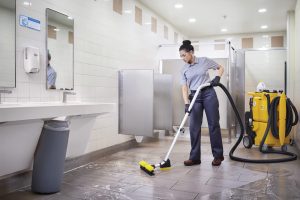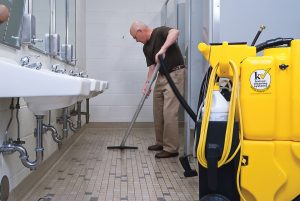— By Robert Kravitz —
Exploring three cleaning technologies that have taken center stage since the pandemic began.
An entire floor of a high-rise office building in Chicago is rented out to a global, “virtual” office company. Most of the tenants rent office space weekly or monthly, and according to the management company, virtually all the spaces on the floor have been rented out.

Robert Kravitz
However, anyone walking on that floor would hardly know that. Virtually every door is closed and locked. Walking in the hallways, it almost feels like you could hear a pin drop. Whereas the floor once had two, and sometimes three, concierges at the floor entry — whose job was to answer phones and provide a variety of other office services — now just one person is in charge, trying his best to stay awake.
The situation is that even though the number of cases of the coronavirus in Chicago has plummeted in the past 3 months and the city has been surprisingly successful in rolling out the vaccine, most people still do not want to return to their offices. And it’s not just office buildings that are quiet, so are retail stores and restaurants throughout the city that have been given the green light to open, but with limited capacity.
So, what’s happened? Many business experts believed — or hoped — that people would rush to get back into the swing of things when we reached this point in the pandemic. While that still may happen, it’s going to take time. According to a recent study in the Associated Press, more than a third of the people in the U.K. are uncomfortable about going to their offices, eating out or shopping.

Photo courtesy of Kaivac.
Based on what we see happening in Chicago, the same unease is felt by millions of people in this country. This means building owners, managers, retailers, restaurant operators and cleaning professionals still have much work to do when it comes to not only cleaning and disinfecting facilities thoroughly — so that people feel safe when they do return — but also educating the public on what they are doing to protect human health.
At least two cleaning technologies have taken center stage since the beginning of the pandemic. Let’s explore these in greater detail so that we better understand them, their popularity and what they can and cannot do.
Let’s also explore a third cleaning technology that has long ago proven its value in removing soil and infection control. Our goal here is not to compare the three as much as it is to ensure we understand what they do — and do not do — so we can protect health and stop the spread of this disease.
Spraying and Fogging
When we talk about “spraying,” we refer to electrostatic sprayers, which have been in use since the 1930s. Their first applications were industrial; they were used, for example, to apply coatings to machinery and cars to help prevent rust buildup. Now, instead of filling these sprayers with chemicals that help prevent rust, they are filled with disinfectants, allowing the disinfectant to be sprayed onto walls, floors, over counters and desks, and a host of other surfaces.
But there is more to it than that. As the disinfectant is released through the machine, it is given a positive electrical charge. The positively charged droplets are attracted to the negatively charged surfaces we just mentioned above.

Photo courtesy of Kaivac.
As the spray travels to these targeted surfaces, it wraps around them and all the objects on those surfaces. This means the entire area has been coated with a disinfectant, so it can begin eliminating pathogens. Further, if it is an N-List disinfectant — tested and approved for eliminating the pathogens that cause the coronavirus — the process helps stop the spread of this disease.
However, unfortunately, there are some caveats. We must be aware of these because, with COVID, there is no room for any false sense of security.
When using disinfectants with electrostatic sprayers, according to Paul Giamona, sales director with WAXIE Sanitary Supply in San Diego, “It’s critical that soils be removed from surfaces before any disinfectant is applied. The presence of soil on a surface will prevent the disinfectant from working effectively.”
This is likely why the U.S. Environmental Protection Agency (EPA) advises that surfaces “should be cleaned prior to disinfecting. If a surface is not cleaned first, the success of the disinfection process can be compromised.”
A similar problem exists with fogging machines. For a disinfecting fogging system to work effectively, surfaces must also first be cleaned.
Just like sprayers, foggers are not a new technology. Instead of spraying surfaces, a disinfecting fogger saturates the air and the area being fogged.
While they can be highly effective at combating pathogens, including those that cause the coronavirus, the fog can remain airborne longer because these droplets are so much smaller. Because of this, it is essential that users wear appropriate masks or respirators when using them.
And one more thing. Be aware that both sprayers and foggers can leave a residue buildup on surfaces, which must be removed for effective cleaning and disinfecting. (See sidebar.)
Remember: In the U.S., disinfectants are officially recognized as pesticides — they kill living things. Inhaling too much disinfectant for too long a period can be dangerous. This is not as critical of an issue when using an electrostatic sprayer.
Cleaning
It appears that whether we use electrostatic sprayers or fogging systems, what is key to their effectiveness is that surfaces be cleaned first.
In many parts of a facility, this can be performed manually. Be sure to use an effective all-purpose cleaner and if using cleaning cloths, microfiber is preferable. Further, change the cloth frequently. If it is changed when the cloth looks soiled, it’s too late. At this point, the user is spreading pathogens, not removing them.
If cleaning larger areas, such as floors and restrooms, including all the fixtures in a restroom, automated cleaning systems should be used. Often recommended are “spray-and-vac” (a.k.a. Kaivac No-Touch Cleaning® systems). These are the advanced cleaning machines referenced earlier.
Studies have shown these systems are as much as 30 times more effective at removing surface soils than traditional methods. Using these machines is a three-step process. However, ISSA, the worldwide cleaning association, reports that even with three steps, they can reduce cleaning times by as much as one-half.
As to the three steps:
- The machine applies cleaning solutions to all surfaces to be cleaned.
- The same areas are then pressure-rinsed, removing pathogens.
- The moisture, soils and pathogens are then vacuumed up.
Further, an N-list disinfectant can be used with at least one type of no-touch cleaning system. Once again, due diligence in equipment selection is necessary.
Now, once these surfaces have been thoroughly cleaned, the sprayers or foggers mentioned earlier can be applied.
As we mentioned earlier, we never want to give anyone a false sense of security, especially with the coronavirus. However, if the steps taken here are performed properly, it should help convince more building users that indoor workspaces, schools, stores and restaurants are now safe — and we can start living our lives once again.
Sidebar:
Foggers in Action
When foggers are used, people, plants and all living things are typically removed from the area for the reasons cited earlier. Doors and windows are closed. Ample time should be allowed before these areas are safe to reenter.
— Robert Kravitz is a frequent writer for the professional cleaning industry.

